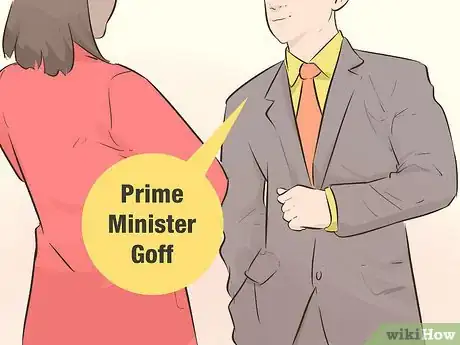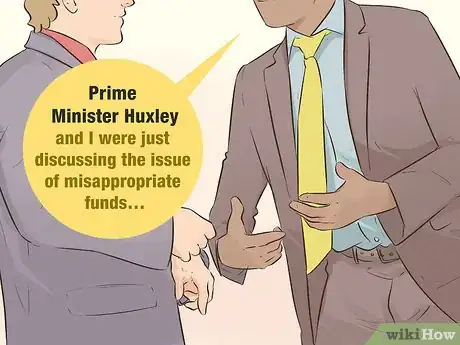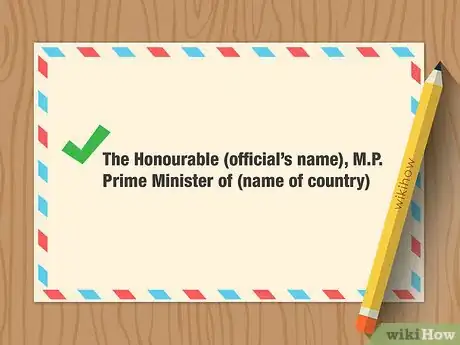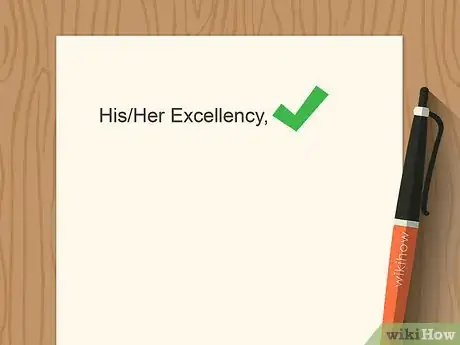This article was co-authored by wikiHow Staff. Our trained team of editors and researchers validate articles for accuracy and comprehensiveness. wikiHow's Content Management Team carefully monitors the work from our editorial staff to ensure that each article is backed by trusted research and meets our high quality standards.
This article has been viewed 25,454 times.
Learn more...
The prime minister serves as the head of state in a parliamentary government, ranking just below the ruling monarch in terms of executive influence. When preparing for a face-to-face meeting with a prime minister, it can be helpful to know the right way to address them. Refer to an acting prime minister within their home country as simply, “Prime Minister,” followed by their surname if you want to add a touch of formality. If you’re addressing a foreign prime minister, use the honorific, “Your Excellency” instead to acknowledge their political stature where they come from.
Steps
Speaking to a Prime Minister
-
1Begin by stating the “Prime Minister” title. Prefacing your communication with a verbal reference to the official’s position is a sign of respect. From there, you can either proceed with your comment or question or follow up with the person’s surname for a more formal effect.[1]
- Depending on where you live, it may or may not be acceptable to use the term “Mr./Madam/Ms. Prime Minister.” This is customary in commonwealth nations, but is generally frowned upon in the U.K., Canada, Australia, and New Zealand.[2]
Tip: If you’re not sure whether or not to employ a prefix, it’s wisest to just go with the honorary customs of your region.
-
2Use, “Your Excellency” if the official is outside of their home country. This is a traditional form of address meant to indicate good will towards an official who is traveling abroad. The reasoning behind the alternative honorific, “Your Excellency” is that the person is only the prime minister of the country they serve, whereas internationally they are a revered guest.[3]
- Similarly, you would say, “His/Her Excellency” when referring to the prime minister in conversation with another person.
- The phrase, “Your Excellency” is also useful for eliminating confusion if the official is visiting another country with its own prime minister.
Advertisement -
3Tack on the person’s surname to follow formal rules of address. After stating the initial honorific, attach the official’s surname. If the prime minister’s name is “Leslie Goff,” for example, you would say, “Prime Minister Goff.”[4]
- There’s no need to use their first name. Saying, “Prime Minister Theresa May” in a personal setting will come off as awkward and unnatural.
- In some cases, it may be alright to switch to a more informal mode of address after your initial show of respect, such as, “Ms. Spencer.”[5]
-
4Avoid using the official’s first name unless you’re a close friend. The only time it’s acceptable to call a prime minister by their given name is if you know them very well, and you’re in a private setting away from other people. Otherwise, it’s best to stick with one of the more respectful honorifics, “Prime Minister” or “Your Excellency.”[6]
- Be careful not to make the mistake of using the prime minister’s first name when talking to someone else about them, too. Instead of saying, “Theodore and I were just discussing the issue of misappropriate funds,” you would want to say, “Prime Minister Huxley and I…”
Writing to a Prime Minister
-
1Address the envelope to “The Honourable (official’s name), M.P.” The abbreviated form of the title, M.P., always comes at the end of the first line. After naming the official, add a second line spelling out their full title. Be sure to specify the name of the country over which they preside, as in, “Prime Minister of (name of country).”[7]
- The completed address on the outside of your envelope should look something like this: “The Honourable William Clay, M.P/Prime Minister of Australia.”
- If the official is distinguished by any other post-nominal identifiers, such as a province key like “B.C.” ( “British Columbia”), be sure to list them right after “M.P.”
Tip: Use the more traditional phrase, “The Right Honourable” when referring to the prime minister of the U.K. or Canada in particular.[8]
-
2Open your letter with the salutation, “Dear Prime Minister.” If you like, you can go on to add the official’s surname, though this isn’t a necessity. Your salutation should either read, “Dear Prime Minister,” or, “Dear Prime Minister Bentley”.[9]
- Don’t try to get fancy with the salutation. Start with the same one you would use for any other formal letter, “Dear.”
- You also have the option of foregoing a salutation altogether by simply saying, “Prime Minister” or, “Prime Minister Bentley.”[10]
-
3Use, “His/Her Excellency” when writing to a foreign prime minister. Don’t forget to include a second line naming the official’s full title and home country, just as you would for an ordinary address. Your completed address will say something like, “Her Excellency Indira Gandhi/Prime Minister of India.”[11]
- “His/Her Excellency” is the correct grammatical format for the outside of an envelope, not, “Your Excellency,” which should only be used when addressing the official directly.
-
4Sign off with the closing, “Yours faithfully,” or something similar. You could also say, “Yours sincerely” or, “Yours respectfully.” The important thing is to extend one final gesture of admiration before ending your letter.[12]
- Sign your letter with your full name, along with any titles you may have that are relevant to your reason for writing.
- As with your salutation, resist the urge to try to dress up your closing too much. A simple and respectful tone tends to work best.
Warnings
- Using an incorrect mode of address, while not a punishable offense, may be considered a faux pas, and definitely isn’t the best way to make a good first impression.⧼thumbs_response⧽
References
- ↑ https://www.aph.gov.au/Senators_and_Members/Guidelines_for_Contacting_Senators_and_Members/How_to_address_Senators_and_Members
- ↑ https://www.canada.ca/en/canadian-heritage/services/protocol-guidelines-special-event/styles-address.html
- ↑ https://www.canada.ca/en/canadian-heritage/services/protocol-guidelines-special-event/styles-address.html
- ↑ https://www.canada.ca/en/canadian-heritage/services/protocol-guidelines-special-event/styles-address.html
- ↑ https://www.aph.gov.au/Senators_and_Members/Guidelines_for_Contacting_Senators_and_Members/How_to_address_Senators_and_Members
- ↑ https://opm.gov.jm/1-devon-rd/protocol/how-to-address-the-head-of-government/
- ↑ https://www.aph.gov.au/Senators_and_Members/Guidelines_for_Contacting_Senators_and_Members/How_to_address_Senators_and_Members
- ↑ http://www.peacemakers.ca/research/Canada/FormsOfAddress.html
- ↑ https://www.aph.gov.au/senators_and_members/guidelines_for_contacting_senators_and_members/how_to_address_senators_and_members
- ↑ https://www.canada.ca/en/canadian-heritage/services/protocol-guidelines-special-event/styles-address.html
- ↑ https://www.canada.ca/en/canadian-heritage/services/protocol-guidelines-special-event/styles-address.html
- ↑ https://www.aph.gov.au/senators_and_members/guidelines_for_contacting_senators_and_members/how_to_address_senators_and_members


































































